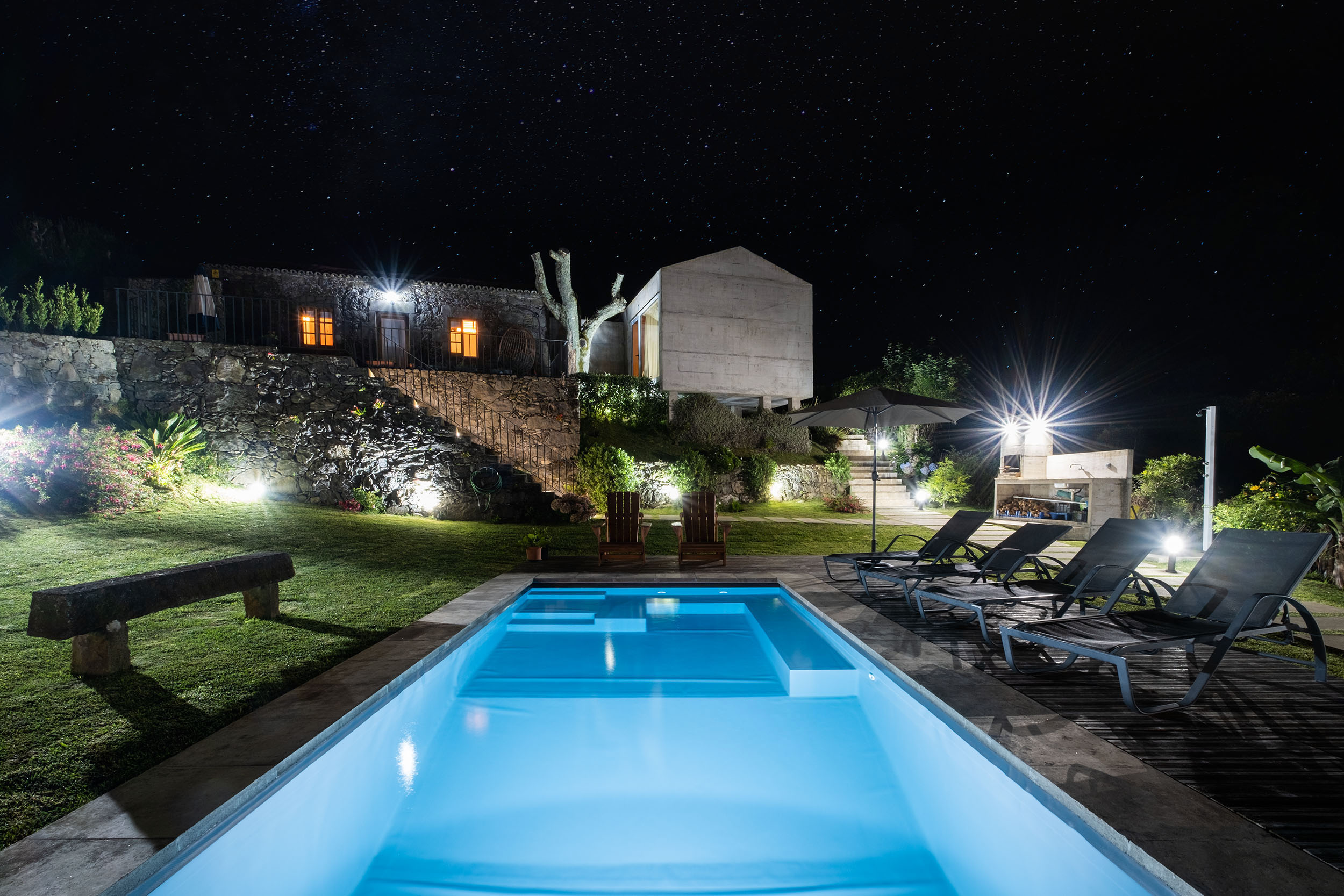The House "Casa do Castanheiro" is a centennial house of the first to be built in this part of the place of the Quarry, in the county of the Northeast, namely in the local Ashtray that gives the name to the nearest street, in the past was where the locals made charcoal from the firewood collected in the surrounding woods, intended to be sold door to door for cooking and heating.
This sunny house is built in stone in the typical architectural style of S. Miguel, with ground floor, oven open top ridge to allow the exit of smoke, stone bench with roof in regional mud tile.
Situated on top of the hill in a privileged place is the last house before the mountain, allowing to enjoy fabulous views of the sea, moonlight that makes the sea look silver, and the mythical sunrise at this end of the island.
Its location allows you to enjoy an interaction with the nature that surrounds it without winters, it is possible to enjoy a privacy almost unique in the days that take place.
Access to it is done through a century-old road, with the house about 80 meters from the current street, this location allows the absence of traffic near the house or even people.
With the recovery started in August 2018, this house was equipped with a new body where two double bedrooms and a bathroom were built, the material used was reinforced concrete to give a feeling of rusticity compatible with the stone of the original body recreating a typical structure, the Guarnel, where in the past cereals were kept off the ground to prevent access of rodents and others.
The connection between the old and the new body was made through a concrete corridor behind the chestnut tree, which gives the name to the house, this centennial tree being preserved in the middle of the house, proportioning with its magnificent canopy in the days in summer a freshness and sensation of being the house inserted in the bosom of the nature that takes us to stay leaning in an afternoon of sun to see the sea and to relax.
The house in its interior is all designed to provide the greatest possible comfort to the guests through its filling, both the materials used in its construction and the cryptomeric wood from the forests of the island itself.
This wood of cryptomeria is very present inside the dwelling so it is one of the most common materials, being present in the ceilings, the kitchen, the built-in cabinets, and the common room which leads to an excellent energy efficiency besides promoting an ecological exploration of this natural recrudescence given its ease of rapid growth.
The floor of the villa is all in pine wood, reinforcing the comfort of the interior coupled with part of the walls and ceiling in cryptomeric we can say that this combination takes our senses to a sensory experience with materials of natural origin to remember the past.
The house has all the latest appliances, wifi in all divisions, cable TV, a salamander located in the living room, all kitchen equipment, double glazing, insulation throughout the house, wardrobes and cabinets built into the bedrooms.
Outside the house has a swimming pool with leisure area equipped with benches with capacity for five people, where clients can indulge in a drink to watch the sea or the moonlight and receive a massage of water in the back through jets built into the pool .
There is also the possibility of heating water up to 29 degrees Celsius through an innovative system, through an electric heat pump that allows a much higher energy efficiency than traditional heating mechanisms that use fossil energies or even pellets. This feature has an extra cost of 20€ per night.
This leisure area also has a solarium with sun loungers in a deck area on one side and grass in the rest area, a shower to support the pool, a large garden with lighting, nightlife, and a barbecue area next to it a bench with electricity and water as well as lighting.
Each bed room has access to the exterior from the same, one of them to the north has access to a small interior garden with lighting, a traditional bank in farm stone. The south facing room leads out to the chestnut tree and later the courtyard in front of the house, the two bedrooms have windowed doors with mirrored glass that allows you to see outside without being seen inside.
In front of the main door of the house there is a stone patio where it is possible to enjoy a meal looking at the sea at sunset or having a drink reading a book, or just listening to the birds.
In the house there is no gas, all energy needs are suppressed by electric power, whether it be for cooking or heating the water.
Guests are offered cleaning and towel change if they wish.
The "Casa do Castanheiro" in the back of the property also has a machine service area and a terrace on the upper landing behind the villa, with a citrus farm with 700 m.
Thus, the "Casa do Castanheiro" combines the comfort that modernity provides us with the history and architecture of the ancestors in a communion with the environment that surrounds it, in an area of 1500 m2, destined exclusively to customers who book in a service that is wants exclusive of great quality.


.jpg)
.jpg)
.jpg)
.jpg)
.jpg)
.jpg)
.jpg)
.jpg)
.jpg)
.jpg)
.jpg)
.jpg)
.jpg)
.jpg)
.jpg)
.jpg)
.jpg)
.jpg)
.jpg)
.jpg)
.jpg)
.jpg)
.jpg)
.jpg)
